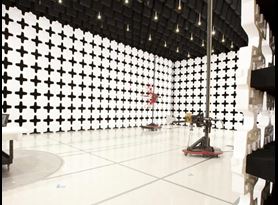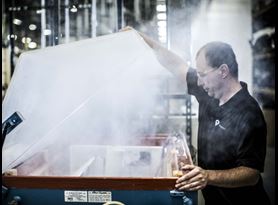RTCA/DO-160 Vibration and Shock Testing FAQ

By Engaged Expert
David LichtmanDavid Lichtman has over 40 years of experience delivering product qualification testing to the global aerospace sector.
RTCA/DO-160 defines types of vibration and shock testing methods. This list of FAQs provides guidance on the categories, procedures, and testing details outlined in the standard.
How are the vibration test categories defined in RTCA/DO-160?
The applicable vibration test category is determined by the level of assurance required by the equipment under vibration conditions from Section 8 of RTCA/DO-160. There is a total of six categories that can be selected and these determine the test methodology and set of vibration test curves that can be applied to the equipment.
The possible vibration tests (and their associated categories) are as follows:
Standard vibration test (Category S)
- Appropriate equipment installed on fixed-wing aircraft to certify that functional performance can be maintained under the vibration environment associated with normal aircraft operation. The test curve to be employed and whether the Sinusoidal Test Procedure or Random Test Procedure is required would depend on the aircraft type and zone.
Robust vibration test (Category R, U, U2)
- Appropriate for equipment installed on fixed-wing or rotary-wing aircraft where both the functional performance and the resistance to effects of long-duration vibration exposure (structural integrity) are assessed.
High-level, short-duration vibration test (Category H, Z)
- Appropriate for equipment whose loss of functional performance would pose a safety risk to the aircraft. This test simulates the high-level short-duration transient vibration environment caused by an engine fan blade loss event.
How long does the vibration testing from RTCA/DO-160 take to perform in a test laboratory?
Several factors can affect the typical laboratory time required to conduct vibration testing from Section 8 of RTCA/DO-160. Typically, this can be split into the following two considerations:
Equipment attributes
- Larger and/or more complex equipment would typically take longer to physically setup on the vibration facility. Complex or lengthy procedures to determine compliance with the equipment performance standards may require further time to complete vibration testing.
Vibration test procedure
- Standard vibration test (Category S) – generally testing can be completed in a single shift for simple equipment given that the test duration for both the sinusoidal and random test procedures are 1 hour/axis.
- Fixed-wing robust vibration test (Category R) – generally, testing can be completed in two shifts for simple equipment given that the test duration for the sinusoidal test procedure is 3 hours/axis (plus dwells) or for the random test procedure is 10 minutes/axis (performance level) and 3 hours/axis (endurance level).
- Rotary-wing robust vibration test (Category R) – generally testing can be completed in two shifts for simple equipment given that the test duration for the sine-on-random test procedure is up to 3 hours/axis (including dwells) (endurance level) and 10 minutes/axis (performance level).
- Rotary-wing robust vibration test (Category U) – generally, testing can be completed in six shifts for simple equipment given that the test has to be repeated three times for Category U and that the duration for the sine-on-random test procedure is up to 3 hours/axis (including dwells) (endurance level) and 10 minutes/axis (performance level) in each instance.
- Fixed-wing high-level, short-duration vibration test (Category H, Z) – generally testing can be completed in a single shift for simple equipment given that the test duration is ~24 minutes/axis.
What is the purpose of operational shock and crash safety testing?
The operational shock test verifies that the unit will continue to function within its expected performance standards following exposure to shocks experienced during normal aircraft operations. The most common shocks occur during taxiing, landing, or turbulence during flight. All equipment that is installed on fixed-wing aircraft or helicopters must undergo the applicable RTCA/DO-160 operational shock test.
The crash safety tests are performed at higher shock levels to verify that equipment will not detach from its mountings and/or cause a hazard during an emergency landing. Equipment is not required to function during a crash safety test. The crash safety shock test is only applicable to equipment installed in compartments or areas where detached equipment could present a hazard during an emergency landings (i.e. fuel systems/evacuation equipment).
When would low-frequency shock testing be required?
Low-frequency shock tests may be applicable if the test specimen has a low resonance frequency. Any low resonance frequencies would be identified during the resonance searches that are performed pre and post-any RTCA DO/160 vibration testing (please see Section 8, RTCA/DO-160 for further details).
What RTCA/DO160 test curve do I need?
The test curve required depends on 2 main factors: what type of aircraft the test specimen will be used in (e.g. helicopter, fixed wing turbojet, multi-engine) and where on the aircraft the test specimen will be located when in service (e.g. fuselage, equipment rack, nacelle, and pylon). It is important to select the correct test curve to allow the test specimen to be subjected to representative in-service vibration levels to provide accurate qualification test data. To assist with identifying the correct test curve, Table 8-1 ‘Categorization and Vibration Test by Aircraft Types and Equipment Locations’ from RTCA/DO-160G, Section 8 should be reviewed.
How can I conduct RTCA/DO-160 Section 7.3.3 sustained crash safety with a large test specimen?
If you have a test specimen that when representatively mounted is too large to fit within a centrifuge, it can still undergo sustained crash safety testing in all 6 directions by the application of a static load. Although RTCA/DO-160G prefers the use of a centrifuge, they acknowledge this is not always practical, given static loading simulates the effects of inertia on the test specimen the method is accepted to demonstrate compliance for RTCA/DO-160G.
The purpose of crash safety testing is to verify that during emergency landing, equipment will not detach from its mountings or separate in a manner that presents a hazard to personnel or essential aircraft systems. To apply a static load, the representatively mounted test specimen is placed in each direction and a specific load is applied through the test specimen's centre of gravity. For example, to crash safety test 9g in the Aft direction, assuming the test be being conducted at sea level, the test specimen will be oriented so its Aft/Forward axis is perpendicular to the floor. The test specimen would be placed on its forward face and a 9kg mass would be applied to the Aft face of the test specimen. If in any orientation the test specimen is not free-standing or the load application area is not suitable (e.g small or angular face), then a test rig to hold the test specimen in place and apply the load would be required.
Additional questions?
If you need further information or would like to request a quote, contact Element today. Our experts can assist in answering your questions and testing your products with certainty to get them to market sooner.
Find related Resources
Get white papers, updates and event invites
Subscribe to content updates
Related Services

EMC Testing Services
Find out how Element delivers electromagnetic compatibility testing (EMC) solutions to RTCA/DO-160, MIL-STD-461 and Def-Stan 59-411 standards.

Environmental Testing
Element can provide you with critically important data on your product or part's performance in response to typical or extreme environmental stresses and conditions.

Vibration and Shock Testing
Element works with manufacturers from the very beginning to try and understand the implications of environmental compliance.

Salt Spray, Salt Fog, and Corrosion Testing
Element's corrosion testing helps you make good decisions about materials selection, treatment, and processes for virtually all industrial situations.

